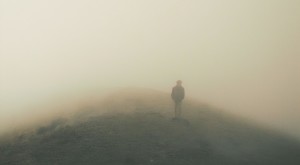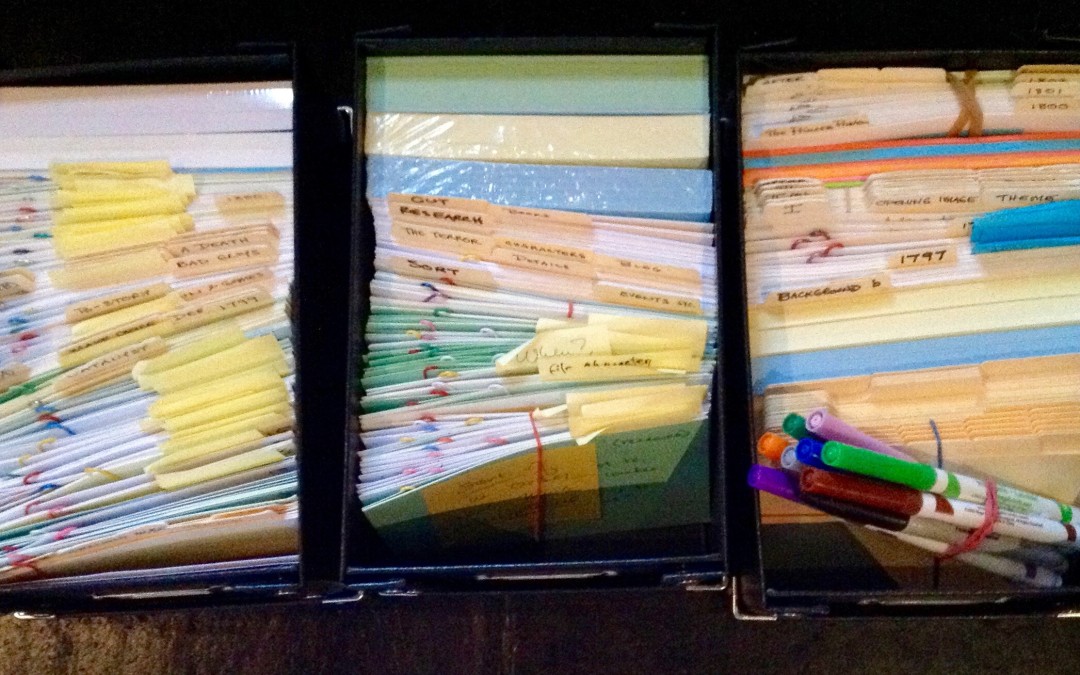
by Sandra Gulland | Jan 4, 2016 | Adventures of a Writing Life, On Plot, The Game of Hope, The Writing Process |
I’ve been flailing, I confess: in Excel plot worksheets, in piles of plot index cards, in Word files summarizing my plot (or trying to), in books on plot, in on-line courses and YouTube videos on plot!

I saw all this as a sign of a project in trouble. I simply couldn’t figure it out! It occurred to me that I was “finished” — but not in a good way.

So last night I was reassured reading A Technique for Producing Ideas by James Webb Young. It turns out that my piles—and piles—of index cards are not a mistake.
I turns out that my Lost-in-the-Very-Deep-Dark-Woods state of mind is simply Stage Two of the Creative Process.
A Technique for Producing Ideas is a slender little book, a classic for marketers … but the wisdom in it applies to any creative endeavour.
For example:
The first [step in producing ideas] is … to gather raw material.
So: all my frenetic searching was not a waste of time? So: my impulse to know everything possible about my subject is not procrastination?
… it you have any sizable job of specific material gathering to do it is useful to learn the card-index method of doing it.
Ah ha!
You take one fact [on an index card], turn it this way and that, look at it in different lights, and feel for the meaning of it. … You bring two facts together and see how they fit … like a jig-saw puzzle.
I especially his description of the “searching” stage of the creative process:
… it is almost like listening for the meaning instead of looking for it.
And, he adds:
When creative people are in this stage of the process they get their reputation for absentmindedness.
So very true.
First, little tentative or partial ideas will come to you. Put these down on paper. Never mind how crazy or incomplete they seem: get them down. These are foreshadowings of the real idea that is to come, and expressing these in words forwards the process. Here again the little 3 × 5 cards are useful.
The second thing that will happen is that, by and by, you will get very tired of trying to fit your puzzle together.
Tell me about it!
Let me beg of you not to get tired too soon. The mind, too, has a second wind. … Keep trying to get one or more partial thoughts onto your little cards.
after a while you will reach the hopeless stage.
Can he read my mind?
Everything is a jumble in your mind, with no clear insight anywhere.
He can!
When you reach this point, … then the second stage … is completed, and you are ready for the third one.
So: Stage One is information gathering (check), and Stage Two is hopelessness (check). What could possibly be next?
In this third stage … you drop the whole subject and put the problem out of your mind as completely as you can. … Listen to music, go to the theater or movies, read poetry or a detective story.
Binge watch Making a Murderer? Going to the beach? All this is not procrastination, avoidance? So all this is Stage Three?
Indeed it is. So what’s Stage Four?
In the first stage you have gathered your food. In the second you have masticated it well. Now the digestive process is on. Let it alone. … if you have really done your part in these three stages of the process you will almost surely experience the fourth.
Which will be?
Out of nowhere the Idea will appear.
Perhaps not surprisingly, reading this slender little tomb, I began to get a rush of ideas … which I quickly scribbled onto index cards.
This is the way ideas come: after you have stopped straining for them and have passed through a period of rest and relaxation from the search.
There is, of course, a final step—Stage Five—and that’s taking “your little newborn idea out into the world of reality.” (I.e.: trying to work it into the complex fabric of the manuscript.)
Do not make the mistake of holding your idea close to your chest at this stage. Submit it to the criticism of the judicious. When you do, a surprising thing will happen. You will find that a good idea has, as it were, self-expanding qualities. … Thus possibilities in it which you have overlooked will come to light.
And so, feeling inspired, ideas popping, I look forward to our two weeks at the beach as Stage Four.
Happy New Year!

by Sandra Gulland | Nov 22, 2015 | Adventures of a Writing Life |
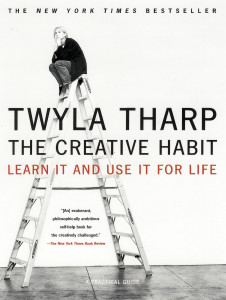
I’ve been recently inspired by Twyla Tharp’s book THE CREATIVE HABIT: LEARN IT AND USE IT FOR LIFE.
Here are some quotes:
Some people find … the moment before creativity begins … so painful that they simply cannot deal with it. They get up and walk away from the computer, the canvas, the keyboard; they take a nap or go shopping or fix lunch or do chores around the house. They procrastinate. In its most extreme form, this terror totally paralyzes people.
After so many years, I’ve learned that being creative is a full-time job with its own daily patterns. That’s why writers, for example, like to establish routines for themselves. The most productive ones get started early in the morning, when the world is quiet, the phones aren’t ringing, and their minds are rested, alert, and not yet polluted by other people’s words. They might set a goal for themselves—write fifteen hundred words, or stay at their desk until noon—but the real secret is that they do this every day. In other words, they are disciplined. Over time, as the daily routines become second nature, discipline morphs into habit.
I know this works, I know this is true: I preach it, yet I don’t always succeed in doing it. Today is an example. I frittered away the morning hours answering emails that I told myself were urgent … but, frankly, anything can wait a few hours.
So: it was just an excuse.
The routine is as much a part of the creative process as the lightning bolt of inspiration, maybe more. And this routine is available to everyone. Creativity is a habit, and the best creativity is a result of good work habits.
Yes, I’m shouting these words! At myself as much as to all of you.
Here are some more delicious quotes:
In order to be creative you have to know how to prepare to be creative …
there’s a process that generates creativity—and you can learn it. And you can make it habitual.
It takes skill to bring something you’ve imagined into the world: to use words to create believable lives, to select the colors and textures of paint to represent a haystack at sunset, to combine ingredients to make a flavorful dish. No one is born with that skill. It is developed through exercise, through repetition, through a blend of learning and reflection that’s both painstaking and rewarding. And it takes time.
If art is the bridge between what you see in your mind and what the world sees, then skill is how you build that bridge.
That’s the reason for the exercises. They will help you develop skill. Some might seem simple. Do them anyway—you can never spend enough time on the basics.
Everything is raw material. Everything is relevant. Everything is usable. Everything feeds into … creativity. Without the time and effort invested in getting ready to create, you can be hit by the thunderbolt and it’ll just leave you stunned.
It’s vital to establish some rituals—automatic but decisive patterns of behaviour—at the beginning of the creative process, when you are most at peril of turning back, chickening out, giving up, or going the wrong way.
Read
this blog post for more quotes and an example of one of the creativity exercises Tharp gives in this book. Always carry a pencil is one. :-)
Who is Twyla Tharp?
Among many other things,
Twyla Tharp is an artist, choreographer, and creator of the smash-hit Broadway show,
Movin’ Out. She has created 130 dances for her company, the Joffrey Ballet, the New York City Ballet, Paris Opera Ballet, London’s Royal Ballet, and American Ballet Theatre. She is 74 now, and far from slowing down:
Choreographer Twyla Tharp brings two bold new works to Kennedy Centre — an interview in
The Washington Post. My hero!
A few great links to share
• Masters of the Everyday: Dutch Artists in the Age of Vermeer. Be sure to click through the individual paintings and read the explanations. It’s wonderful how you can zoom in for a close look. I especially liked “The listening Housewife.” For a review of this exhibit, read this post.

• Why Your Critics Aren’t The Ones Who Count, an inspiring— and funny—Ted-type talk by Brené Brown.
What I’m up to
I’m having a hard time with the revision of Moonsick. I keep stirring the pot, but it’s slow to thicken. This beautiful photo of “Man in a fog” by Harman Wardani feels perfectly expressive of my state of mind.
Reading Tharp’s book, I realized that I have a ritual that triggers creativity: I record the day’s writing goals in a notebook and — bam! — I’m off to the races.
You may have noticed that my website is being revised (so that it will be visible on all devices). It’s still in the construction phase, so please bear with us.
The world news continues to be both distracting and extremely distressing. This cartoon, which I posted to FaceBook, has been getting a lot of “likes,” so I gather most everyone feels the same:
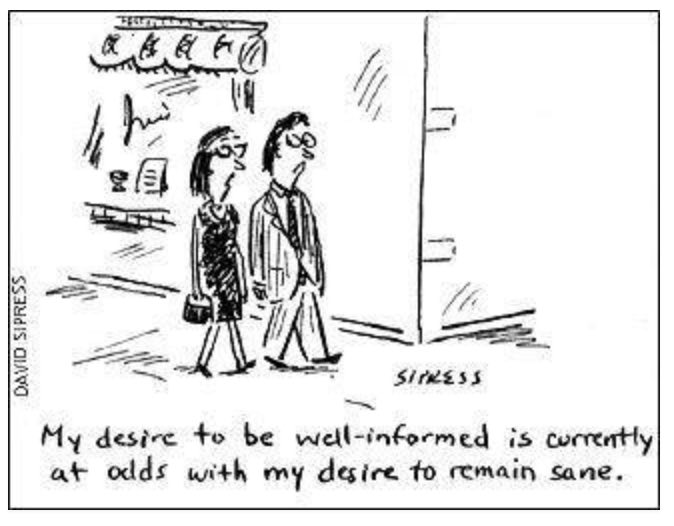
Have a good week … . Stay sane!
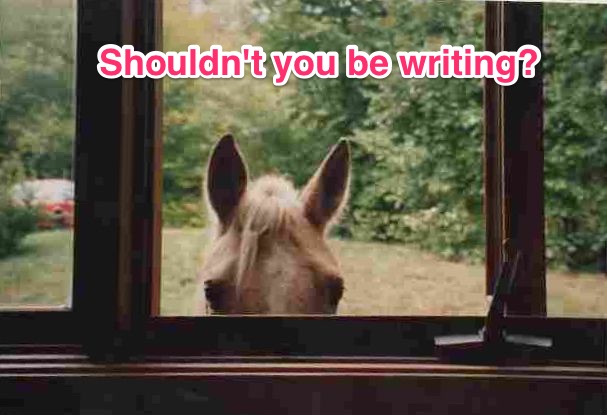
by Sandra Gulland | Nov 17, 2015 | Adventures of a Writing Life, Resources for Writers, The Writing Process |
Yes, I should!
I’ve been MIA: sorry.
I have far too much going on, and now … the international news is devastating. A novelist by nature spins out horrific scenarios. It helps to curl up in a fictional world.
A few links to share …
• Coincidentally, I’m reading The War Reporter by my SMA and FB friend Martin Fletcher: set in Syria. It’s excellent: I recommend it. Martin has been an award-winning foreign correspondent in Middle East hotspots for much of his life: he knows whereof he speaks and he’s a fine writer.
• In the much-needed calming department: The ONE Thing You Need To Do On Sunday For A Stress-Free Week. Excellent advice.
Especially for us history geeks …
• Mr. Darcy Strips off … It’s often difficult to find out what’s under those clothes, and even more difficult to find out how they’re put on … or how they come off. :-)
And last, for writers in need of a title …
• This list of titles of 18th century novels is hilarious. It’s really so hard to choose. Here are a few of my favourites:
The Expedition Of Little Pickle; Or, The Pretty Plotter
He’s Always In The Way
Love And Madness. A Story Too True. In A Series Of Letters Between Parties Whose Names Would Perhaps Be Mentioned Were They Less Well Known Or Less Lamented
I took the photo at top decades ago. I was working at my desk (and yes, likely writing), and I looked up to see our Palomino Bailey looking in the window. Miraculously, I was able to get a photo.
(Every time I look at this shot, I think: she needs her forelock combed!)
I have joined an informal NaNoWriMo Facebook group which is helping me keep on track. Speaking of which …
YES, I should be writing.
Have a good week. Send healing thoughts out into this sad and far-too-violent world.

by Sandra Gulland | Sep 20, 2015 | Adventures of a Writing Life, Resources for Writers, The Writing Process |
We had little more excitement this week than we cared for!
{A cloudy NY offered wonderful photo opportunities. I especially enjoyed catching the suggestive night window dressing moment on the Highline.}
After a wonderful trip to NY to see our son, we arrived home in good time on Tuesday, only to be overwhelmed by the sickening smell of dead mouse wafting throughout the house. We quickly threw down our suitcases, opened all windows and doors and set five fans blowing.
Shortly after, the power went out (but not because of the fans), and shortly after that there was a terrifying series of extremely loud explosions. I found out what I do in such a case: I run in and out of the house trembling. (Handy to know: there’s an explosion in my next YA about Hortense.) We thought it must have been the meter, triggered somehow by our new electrical furnace.
It was 6:00 by this time. We were afraid to use our generator under the circumstances, so we set out all the candles and flashlights, the land-line telephone, and closed the windows and doors since we wouldn’t have heat for the night. By then we’d thought better of staying. Instead, we’d have a quick dinner while there was still light, then pack up and move to our cabin on a lake. It was in a state of disruption due to work being done on it, but at least it had electricity, toilets and a Net connection. Who knew how long we would be without power at the house? In the morning we would contact the furnace and electrical companies.
The next morning, the furnace turned out not to be the villain, but the dead mouse was found. (Yes!) Then the electricity crew came out. A transformer on the telephone pole 100 ft. from our house had exploded. Why, we don’t know. It had been a calm, cloudless day.
The power was going to be out at the house for some time, so we packed up more gear and returned to the cabin, where—groan—we discovered that the power had gone out due to a problem in a village some distance from us.
So: back to the house, having since learned that we could safely use the generator.
We returned to a house littered with open suitcases, dirty dishes, candles and fans—but blessedly odour-free.
That evening, however, a friend encountered a very large bear at the top of our driveway. I was waiting for her not 25 feet away.
TMI? I just had to share.
It’s a pleasure to get back to what might be considered Normal Life. However, there are two things I should put on my To Do List every day, for inevitably they have to be dealt with:
- 1 hour: puzzle out why Net/computer/software isn’t working.
- ½ hour: search for something I’ve misplaced.
Here was my To Do List for today:
- 1 hr. exercise
- 2 hrs. puzzle out plot
- 1 hr. Skype French lesson
- chat with our son & daughter
- ½ hour weeding
- 1 hr. taxes
- ½ hr. watercolour painting
- blog post
I am down to the last one: this blog post. It helps to wake at 4:00 with a compelling idea on how to tackle the plot revision. (More on that later.)
My Sundry Sundae delectable links for this week:

Links for writers …
• 3 Simple Prewriting Strategies.
• The Units of Story: The Sequence. There is a lot to learn in this series from StoryGrid.com.
Links for Napoleonistas people with a sick sense of humour …
• Okay, this is a little sick: Napoleonistas as well as parents will be understandably offended by this account of how Napoleon died, as told by stinking drunk kids. (The Drunk History series is rather amusing.)
Links for Sun King enthusiasts …
• There has been quite a bit again this week on the Sun King because September 1st was the 300th anniversary of his death. Here is a big treat for you all: The King Who Invented Ballet, a wonderful BBC documentary on how Louis XIV invented ballet. At the end of the video is the ballet. Heavenly! (Note: if for some reason you can’t watch this video here, you can watch it on YouTube.)

• Accompany this with a Forbes article: How Ballet Can Make You A Better Leader.
Have a great week!

by Sandra Gulland | Sep 10, 2015 | Adventures of a Writing Life, Resources, Resources for Writers, The Writing Process |
Another whirlwind week. Is there any other kind? We’re leaving for NY today—a five-day visit with our son.
I’d told my editor and agent that I would have the revised first section of the WIP to them before I left, and I’ve been working toward that deadline.
Meeting a deadline—a commitment to send out—invariably entails many sleepless nights, which creates a certain frenetic heat. The creative cauldron, I think of it.
At the beginning of this period, I had lost faith the work and, worse, lost faith in my ability to write at all. Despair! As I worked on the MS, I was also composing, at the same time, a draft of a resignation letter.
In the heat of the cauldron, however, I began making big changes, revising the pages over and over again. By D-Day, the day to send—which was only the day before yesterday—I was, miraculously, actually pleased with the work.
And off it went, without that letter of resignation. I had gone from despair to elation in a matter of days.
Now: time for a holiday!
This week’s delicious Sundae Sundries

Links for writers & other creatives …
• Nine Secrets to Successfully Completing that Elusive First Draft. Or that elusive fifth draft, for that matter. :-( This is a very good article.
• The most popular article in my Flipboard magazine this week, not surprisingly, was: Rude awakening: three essential rules for writing good sex. This is a helpful article.
• This is funny: Free Blurbs for Your Book!
• I love this: How Reading (and Writing) Obituaries Can Improve Your Fiction.
• 9 Creativity Tips You Can Learn from Geniuses. Many good suggestions!
Links for Sun King enthusiastists …
There is quite a bit on the Net right now on the Sun King because of the 300th anniversary of his death on September 1. Here are a few I like:
• Louis XIV: The Sun King & the Arts.
• How Ballet Can Make You A Better Leader.
• Louis XIV: What France’s Sun King did for art.
• This post launches a wonderful Wallace Collection series on the Sun King.
One thing I always think about with respect to the Sun King’s death is how his wife, Madame Maintenon, left at the very end; she wasn’t by his side when he passed. This has been interpreted by some as heartlessness, but my feeling—entirely subjective—is that we don’t understand life without pain killers. The presence of loved ones can make it harder for the dying to “let go.” Leaving would be considered a mercy.
On that somber note: have a great week!









